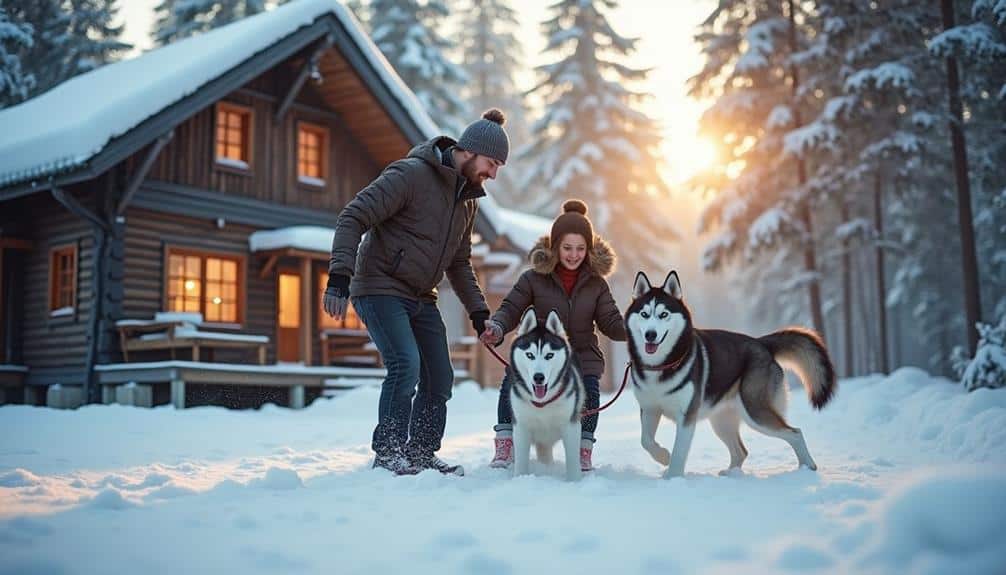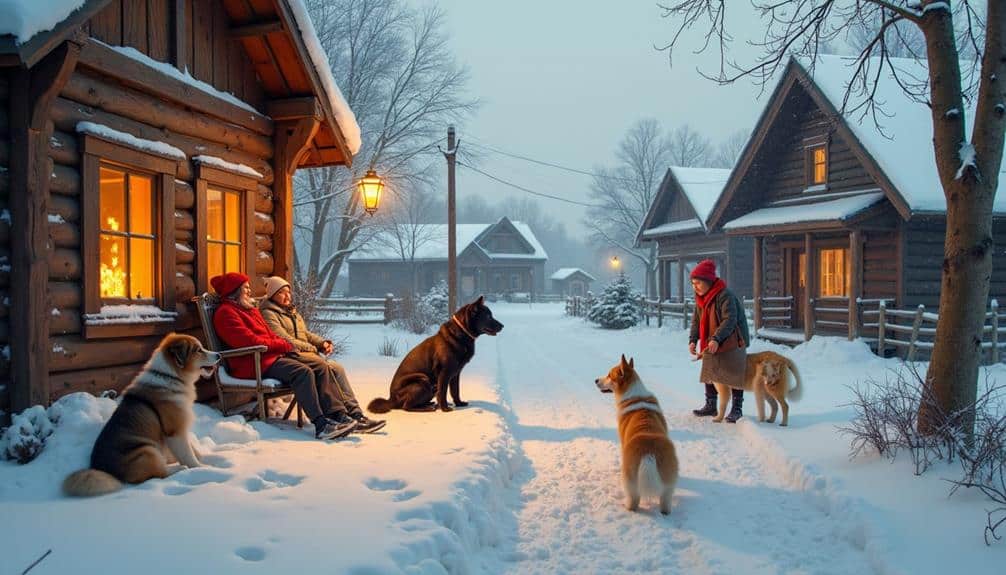Introduction

The bond between Russians and their dogs is both profound and multifaceted, reflecting the significant role of canines in Russian culture.
Statistically, dog ownership in Russia remains high, with recent surveys indicating that approximately 40% of households have at least one dog.
This widespread popularity underscores the deep-rooted affection and cultural importance of dogs, evident in various aspects of daily life and historical traditions.
Significance of Dogs in Russian Culture
Rooted deeply in the annals of Russian history, the bond between Russians and their dogs manifests through various cultural expressions and societal norms. Historically, specific dog breeds such as the Borzoi and the Laika have been integral to Russian culture, serving roles from hunting to companionship.
These breeds are not only preserved as a reflection of Russia’s rich heritage but also celebrated in contemporary canine training practices.
Pet etiquette in Russia reflects a deep respect for dogs, underpinned by a societal understanding of their importance. Dog owners exhibit meticulous care in training their pets, ensuring they are well-mannered and socially integrated.
This is evident in urban dog parks, which provide a communal space for dogs and their owners, fostering social interaction and promoting responsible pet ownership.
Breed preservation remains a significant aspect of Russian culture. Efforts to maintain genetic purity and health are apparent in the dedicated breeding programs across the country.
These programs highlight a commitment to sustaining the historical and cultural significance of native dog breeds.
In essence, the significance of dogs in Russian culture is multifaceted, encompassing historical reverence, modern training methodologies, and a collective commitment to ethical pet etiquette and breed preservation.
Statistics and Popularity on Dog Ownership in Russia
Although Russia’s extensive history with dogs is well-documented, contemporary data sheds light on the current trends and statistics surrounding dog ownership in the country. Recent surveys indicate that approximately 40% of Russian households own at least one dog, demonstrating a robust culture of pet ownership.
Urban living conditions have influenced the popularity of certain dog breeds, with smaller, adaptable breeds like the Yorkshire Terrier and French Bulldog becoming increasingly favored in metropolitan areas.
Veterinary care has also seen significant advancements, with more Russians opting for regular check-ups and preventive treatments for their pets. This trend correlates with an increased awareness of the health benefits and responsibilities associated with dog ownership.
Training practices have evolved as well, with a rise in professional dog training services and a growing interest in positive reinforcement techniques.
Moreover, demographic studies reveal that pet ownership is particularly prevalent among younger generations, who view dogs as integral to their lifestyle and mental well-being.
These statistics underscore the dynamic relationship between Russians and their canine companions, reflecting broader social trends that emphasize well-rounded veterinary care, responsible pet ownership, and adaptive training practices.
Historical Context
The history of dog ownership in Russia has evolved considerably, from their traditional roles as working animals in agrarian societies to their current status as cherished companions in urban environments.
Historically, dogs were integral to rural life, assisting in herding, hunting, and protecting livestock, which underscores their multifunctional utility.
This enduring relationship has been shaped by sociocultural factors, reflecting both the practical and emotional bonds between Russians and their dogs throughout different periods.
Evolution of Dog Ownership in Russia
Throughout Russia’s extensive history, the role of dogs has evolved considerably, reflecting broader societal changes. Initially, various dog breeds in Russia served practical purposes, such as hunting, herding, and guarding.
Over the centuries, as Russia changed from agrarian to industrial society, the nature of dog ownership shifted. The late 19th and early 20th centuries saw an increase in urbanization, necessitating changes in training practices and the development of pet services.
Urban regulations began to emerge, addressing the complexities of keeping dogs in densely populated areas. This period also introduced ownership challenges, including the need for proper training to guarantee dogs adapted to urban living.
The Soviet era further influenced dog ownership, with state-sponsored kennels and regulated breeding programs focusing on specific breeds for security and military purposes.
Post-Soviet Russia has seen a resurgence in dog ownership as a sign of personal freedom and societal status. Modern pet services have proliferated, offering everything from grooming to specialized training classes.
However, challenges persist, such as managing stray populations and guaranteeing responsible ownership. Today, dogs are cherished companions, integral to the social fabric of Russia, symbolizing loyalty and affection amidst evolving urban landscapes.
Traditional Roles of Dogs
From ancient times, dogs have held pivotal roles in Russian society, often serving as indispensable companions in various functional capacities. Historically, working breeds have been integral to agricultural and pastoral communities, with their herding instincts ensuring the efficient management of livestock. Breeds such as the Russian Ovcharka excel in this domain, showcasing their innate ability to protect and guide herds.
In the domain of hunting, dogs have been invaluable hunting companions to Russian nobility and peasants alike. The Borzoi, for instance, is renowned for its speed and agility, making it an ideal partner in the pursuit of game. These hunting breeds were not merely tools but respected members of the hunting expeditions, embodying a symbiotic relationship between man and animal.
Additionally, the utilization of dogs in rescue missions has been documented, particularly in the harsh Siberian landscapes where their endurance and keen senses are vital.
Therapy dogs, although a more contemporary role, have also found their place in Russian society, aiding in mental health and offering emotional support.
Thus, the traditional roles of dogs in Russia are multifaceted and deeply embedded in the country’s cultural and historical fabric, reflecting their enduring significance.
Cultural Representations of Dogs

Embedded within Russian culture, dogs have been portrayed through various artistic and literary mediums, reflecting their multifaceted roles in society. Dog symbolism in Russia often embodies loyalty, protection, and companionship. In literary works, dogs frequently serve as metaphors for human virtues and flaws. For instance, the dog Sharik in Mikhail Bulgakov’s “Heart of a Dog” symbolizes the complexities of Soviet society, while the works of Anton Chekhov often feature dogs to illustrate the human condition.
Dog folklore in Russia is rich with tales of mythical canines that guard treasures or serve as omens. Such folklore underscores the deep cultural reverence for dogs as both protectors and guides.
In the domain of canine art, Russian painters like Pyotr Konchalovsky have captured the essence of dogs in rural life, emphasizing their integral role in pastoral settings.
Dogs in film also hold a significant place, with movies such as “White Bim Black Ear” poignantly exploring themes of loyalty and loss through the eyes of a dog.
These cultural representations collectively highlight how dogs are intertwined with Russian identity, offering insights into societal values and human-animal relationships.
Current Trends in Dog Ownership
As cultural representations of dogs in Russian literature, art, and film illustrate their deep-seated significance, examining current trends in dog ownership reveals evolving attitudes and practices.
One prominent trend is the increase in dog training programs, reflecting a growing awareness of the importance of behavioral guidance. Russian dog owners are increasingly enrolling their pets in classes that range from basic obedience to specialized training for canine sports such as agility and flyball, signifying a shift towards structured interaction.
Additionally, the rise of pet fashion indicates a burgeoning market for canine accessories and apparel. This trend not only emphasizes aesthetic preferences but also highlights the anthropomorphization of pets, as owners seek to include dogs in their lifestyle choices.
Dog friendly cafes are becoming ubiquitous in urban centers, providing communal spaces where pet owners can socialize, thereby reinforcing the social dimension of dog ownership.
Finally, adoption trends show a marked preference for rescuing dogs from shelters rather than purchasing from breeders, reflecting a societal shift towards ethical considerations in pet ownership.
These trends collectively demonstrate a multi-faceted evolution in the relationship between Russians and their dogs, underscoring a blend of traditional affection with contemporary practices.
Emotional bonds between Russians and their dogs
 The emotional bonds between Russians and their dogs are profound and multifaceted, rooted in a combination of historical, social, and psychological factors. Canine companionship in Russia offers more than mere friendship; it is a cornerstone of emotional support for many individuals.
The emotional bonds between Russians and their dogs are profound and multifaceted, rooted in a combination of historical, social, and psychological factors. Canine companionship in Russia offers more than mere friendship; it is a cornerstone of emotional support for many individuals.The loyalty dynamics between Russians and their dogs are particularly strong, often reflecting deep mutual trust and affection. This bond is not only a personal experience but also a cultural phenomenon that underscores the importance of pets in emotional well-being.
Historically, dogs in Russia have transcended their roles as mere pets to become essential elements of social connections within communities. The therapeutic benefits of pet therapy are well-documented, demonstrating how interactions with dogs can alleviate stress, anxiety, and even depression.
In Russia, this therapeutic aspect is widely recognized, with many people relying on their dogs for emotional stability and comfort. Moreover, the loyalty dynamics between dogs and their owners further enhance these emotional connections.
The unwavering loyalty exhibited by dogs encourages a reciprocal sense of responsibility and affection from their owners. Consequently, the emotional bonds between Russians and their dogs encapsulate a unique blend of companionship, emotional support, and social interconnectedness.
Dogs in Community Life
Beyond the deeply personal emotional connections between Russians and their dogs, these animals also hold significant roles within community life.
In urban and rural settings alike, dogs facilitate social interactions among residents, often serving as catalysts for community bonding during routine walks and organized community events. The presence of dogs in public spaces encourages spontaneous conversations and fosters a sense of camaraderie among dog owners.
Dog training programs also play a pivotal role in the community, offering structured environments where owners can bond with their pets while enhancing their dogs’ behavior and skills.
These programs often incorporate communal elements, such as group classes and public demonstrations, enhancing social cohesion.
Moreover, dogs are integral to various rescue initiatives. Trained canines assist in search and rescue operations, particularly in Russia’s vast and challenging terrains, showcasing their indispensable utility beyond companionship.
Neighborhood watch programs also benefit from the vigilant presence of dogs. Their acute senses and natural protective instincts contribute to community safety, offering an added layer of security.
Conclusion
To summarize, the bond between Russians and their dogs is deeply embedded in the nation’s cultural and historical fabric. This relationship has evolved from utilitarian roles to one characterized by emotional attachment and mutual respect. Current trends in dog ownership underscore a commitment to ethical care and responsible pet management. The presence of dogs in community life further illustrates their integral role in fostering social connections and enhancing communal well-being, reflecting a unique and enduring human-animal bond.




